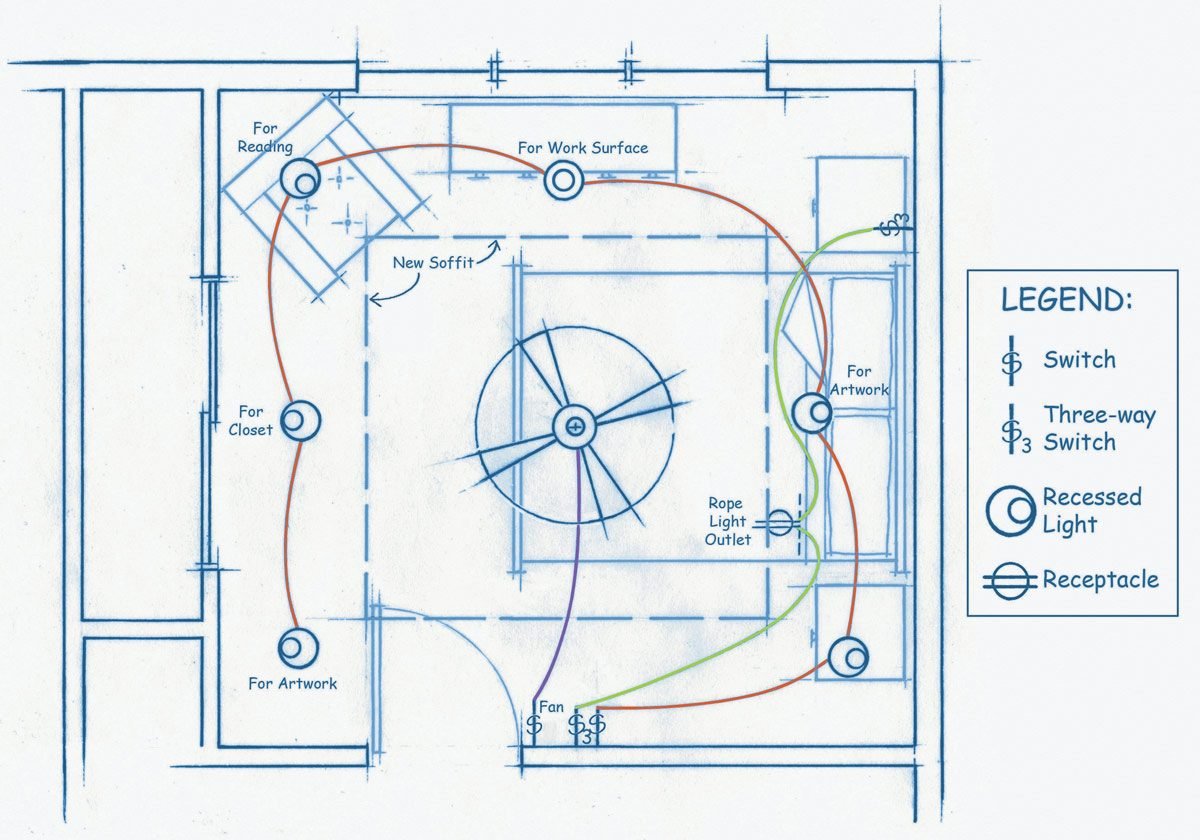Have a DIY electrical project but find wiring diagrams confusing? Take them step by step, and soon you'll be wiring like a pro.

Guide To Wiring Diagrams

I laugh about it today. But when I was a second-year apprentice and my foreman handed me a wiring diagram, I briefly panicked. I saw a bunch of boxes and a lot of seemingly randomly drawn lines. It looked like a jumble of spaghetti, with square meatballs.
“Sure, I’ve seen those before,” I said eagerly. Luckily, I know my limits, so my next words were: “But can you go over it with me?”
Three years later, I’m wiring the lighting control system (a network of lights, switches, sensors and relays) for a computerized tomography (CT) room at a major hospital. How did I go from uncertain apprentice to wiring diagram whiz?
For me, it was time and patience, often on the part of my instructors. But I’ll bet you don’t have three years to figure this out — you have an electrical project right now. So how do you read an electrical wiring diagram? And what are they, anyway?
Let’s walk through them together.
On This Page
What Is a Wiring Diagram?
A wiring diagram is a simplified representation of the conductors (wires) and components (devices, lights, motors, switches, sensors and more) that make up an electrical circuit or electrical system. Some wiring diagrams show the exact wire connections that must be made for the system to work, while others offer a graphical representation of how electricity flows through a circuit.
Wiring diagrams can be simple (a single receptacle) or complex (lighting controls in the CT room). A receptacle wiring diagram features pictures or line drawings of the receptacle and the power supply wires. It shows the installer exactly where on the receptacle to attach the hot, neutral and ground electrical wires.
More complex systems like the CT room have a diagram showing the system’s overall layout, as well as more detailed diagrams of the individual components and how they’re tied together.
Wiring diagrams are often easier to interpret than written directions, especially for people unfamiliar with electrical systems and concepts. If you can take your finger and trace a line from one place to another, you can follow a wiring diagram. Here are a few tips for drawing your electrical plan.
What Is a Wiring Diagram Used For?
A wiring diagram distills complex information into an easy-to-follow visual graphic. Wiring diagrams are great for installing electrical devices and troubleshooting when a system isn’t working.
Let’s say you want to install an movement sensor to turn off the lights and air conditioning when you’re not home. It might have six or more wires sticking out of it when you pull it out of the box. Which wire goes where? Do they all get connected? A wiring diagram lays it all out.
Wiring diagrams aren’t just for external components, like connecting the movement sensor to power, lights, heating, ventilation and air-conditioning (HVAC) equipment. Wiring diagrams also apply to internal wiring, like a circuit board inside a computer or washing machine. Here are a few tips for wiring an air conditioner.
Wiring diagrams can also represent how electricity flows in a circuit. These diagrams show the power source and voltage, as well as the loads (lights and equipment) and any components that affect the flow of electricity, like switches. This type, called a schematic, is most often used by engineers and other electrical professionals.
How To Read a Wiring Diagram
First, find a reference point. This could be the power supply or the light or sensor that you’re installing. Look at the picture and find the wires coming off the device. Follow the lines to see where they terminate. They might not all go to the same place. The movement sensor will have some wires that go to a transformer, and others to HVAC equipment and lights.
If you see a dot at the intersection of two or more lines, splice those wires together. But if a line “jumps” over another one in a half-moon shape or crosses another with no dot, don’t splice them..
The wiring diagram shows where to connect each wire on the device. A receptacle diagram might use common electrical terms such as “Line In,” which means the hot wire from the power supply, “Neutral” and “Ground.” Or it could say “Black,” “White” and “Green.” Make the connections precisely as directed or the device won’t work.
Diagrams showing electrical flow through a circuit use standardized symbols to represent electrical components. Ground is a vertical line with three successively smaller horizontal lines underneath. Switches are diagonal lines emanating from the line representing the electrical flow.
To read these diagrams, start at the power source and follow the line through all the components of the system.
Types of Wiring Diagrams
There are three basic types of wiring diagrams:
- Wiring: Depicts electrical devices as drawings or pictures connected by lines representing wires. Wiring diagrams show specific electrical connections.
- Pictorial: Shows how components are related to others on the same circuit, but contains less detailed information about electrical connections.
- Schematic: Represents the flow of electricity through a circuit and its components. Drawn with standardized symbols.
Homeowners doing DIY electrical work are most likely to go with basic wiring and pictorial diagrams, usually included in the instructions for electrical devices.




















